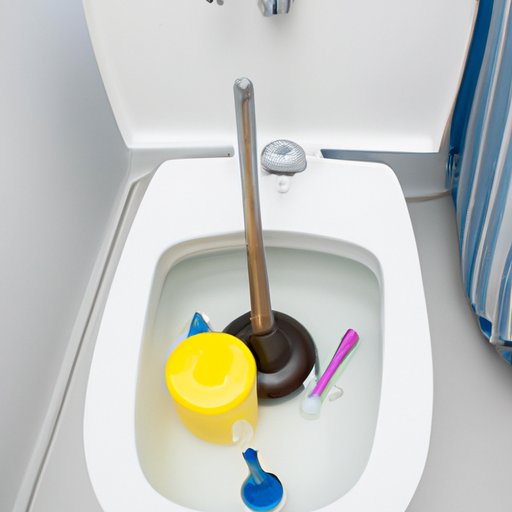
Introduction
One of the most common household problems that can cause major inconvenience is a clogged toilet. Not only does it cause unpleasant odors, but it can also lead to water damage and expensive repairs if not dealt with properly. The purpose of this article is to provide various solutions to unclog a toilet, from chemical solutions to natural alternatives and professional help.
Chemical Solutions
Drano and Max Gel are common chemical solutions available in most stores. They work by dissolving the clog and allowing the water to pass through easily. However, they are harsh and can damage your pipes if not used correctly.
When using chemical solutions, always follow the instructions on the label and wear protective gear such as gloves and goggles. Never mix different chemical products together, as this can create dangerous fumes.
Plunger
A plunger is a common tool used to unclog toilets. There are two types of plungers available in the market – the flat bottom and the flange plunger. The flat bottom is best for sinks and the flange plunger is best for toilets.
To properly use a plunger, start by creating a seal around the toilet bowl drain. Plunge vigorously up and down until the water starts to drain. Repeat as necessary.
To ensure effective plunging, make sure there is enough water in the bowl to create suction. Cover any overflow holes with duct tape to create a better seal.
Hot Water and Dish Soap
One natural alternative to chemical solutions is using hot water and dish soap. This method is safer for your pipes and better for the environment.
To use this method, start by adding a few squirts of dish soap to the toilet bowl. Then, pour hot water into the toilet bowl from a height of about three feet. The force of the hot water will help break down the clog.
Make sure the water is not boiling hot, as this can crack the porcelain. Also, do not use this method if you have a septic system, as the soap can harm the system.
Toilet Auger
A toilet auger is a tool specifically designed for unclogging toilets. It has a long cable with a curved tip that can reach the clog and break it up.
To use a toilet auger, insert the cable into the toilet bowl and turn the handle clockwise until you feel resistance. This means it has reached the clog. Then, turn the handle counterclockwise to break up the clog.
Always wear gloves when using a toilet auger, and do not force the auger cable as this can damage the toilet.
Baking Soda and Vinegar
Baking soda and vinegar is another natural alternative to chemical solutions. Baking soda has abrasive properties that help break up the clog, while vinegar is acidic and dissolves the blockage.
To use this method, pour one cup of baking soda into the toilet bowl and then add one cup of vinegar. Cover the toilet bowl with a lid and let it sit for about 30 minutes. Then, flush the toilet to see if the clog has cleared.
Do not use this method if you have recently used a chemical solution, as the two can react and create dangerous fumes.
Professional Help
If none of the above solutions work, it may be time to call a professional plumber. A professional plumber has the expertise and tools to unclog your toilet safely and effectively.
To choose the right plumbing service, look for a licensed and insured plumber with good reviews. Get quotes from multiple plumbers and compare prices. Also, ask about their guarantees and warranties.
While hiring a professional is more expensive, it can save you time and money in the long run. Plumbers also provide helpful tips for preventing future clogs.
Conclusion
Clogged toilets are a common household problem, but there are many solutions available to unclog them. From chemical solutions to natural alternatives and professional help, there is a method for everyone. Always follow safety precautions and try these solutions before calling a professional. To prevent future clogs, avoid flushing non-degradable items and use less toilet paper.





